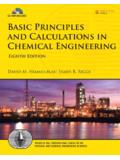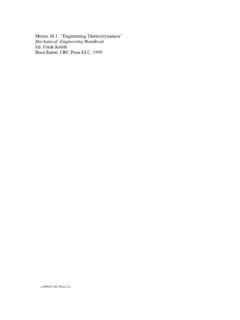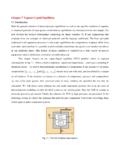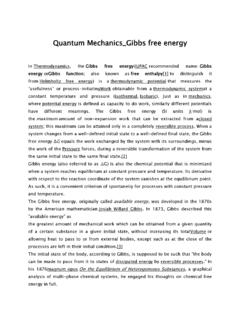Transcription of PHYSICAL CHEMISTRY IN BRIEF - vscht.cz
1 PHYSICAL CHEMISTRYIN BRIEFProf. Ing. Anatol Malijevsk y, CSc., et al.(September 30, 2005)Institute of chemical Technology, PragueFaculty of chemical EngineeringAnnotationThePhysical CHEMISTRY In Briefoffers a digest of all major formulas, terms and definitionsneeded for an understanding of the subject. They are illustrated by schematic figures, simpleworked-out examples, and a short accompanying text. The concept of the book makes itdifferent from common university or PHYSICAL CHEMISTRY textbooks. In terms of contents, thePhysical CHEMISTRY In Briefembraces the fundamental course in PHYSICAL CHEMISTRY as taughtat the Institute of chemical Technology, Prague, the state behaviour of gases, liquids,solid substances and their mixtures, the fundamentals of chemical thermodynamics, phaseequilibrium, chemical equilibrium, the fundamentals of electrochemistry, chemical kinetics andthe kinetics of transport processes, colloid CHEMISTRY , and partly also the structure of substancesand spectra.
2 The reader is assumed to have a reasonable knowledge of mathematics at the levelof secondary school, and of the fundamentals of mathematics as taught at the university Ing. Josef P. Nov ak, Ing. Stanislav Lab k, Ivona Malijevsk a, students, PHYSICAL CHEMISTRY is generally considered to be a difficult subject. We thought long andhard about ways to make its study easier, and this text is the result of our endeavors. Thebook provides accurate definitions of terms, definitions of major quantities, and a number ofrelations including specification of the conditions under which they are valid. It also containsa number of schematic figures and examples that clarify the accompanying text. The readerwill not find any derivations in this book, although frequent references are made to the initialformulas from which the respective relations are terms of contents, we followed the syllabi of PHYSICAL CHEMISTRY I and PHYSICAL Chem-istry II as taught at the Institute of chemical Technology (ICT), Prague up to 2005.
3 Howeverthe extent of this work is a little broader as our objective was to cover all the major fields ofPhysical publication is not intended to substitute for any textbooks or books of examples. Yetwe believe that it will prove useful during revision lessons leading up to an exam in PhysicalChemistry or prior to the final (state) examination, as well as during postgraduate experts in PHYSICAL CHEMISTRY and related fields may find this work to be useful as CHEMISTRY In Briefhas two predecessors, Breviary of PHYSICAL CHEMISTRY I and Breviary of PHYSICAL CHEMISTRY II . Since the first issue in 1993, the texts have been revisedand re-published many times, always selling out. Over the course of time we have thus strivento eliminate both factual and formal errors, as well as to review and rewrite the less accessiblepassages pointed out to us by both students and colleagues in the Department of PhysicalChemistry.
4 Finally, as the number of foreign students coming to study at our institute continuesto grow, we decided to give them a proven tool written in the English language. This text is theresult of these efforts. A number of changes have been made to the text and the contents havebeen partially extended. We will be grateful to any reader able to detect and inform us of anyerrors in our work. Finally, the authors would like to express their thanks to Mrs. Flemrov afor her substantial investment in translating this [CONTENTS] 51 Basic Thermodynamic system.. Isolated system.. Closed system.. Open system.. Phase, homogeneous and heterogeneous systems.. Energy.. Heat.. Work.. Thermodynamic quantities.. Intensive and extensive thermodynamic quantities.
5 The state of a system and its changes.. The state of thermodynamic equilibrium.. System s transition to the state of equilibrium.. Thermodynamic process.. Reversible and irreversible processes.. Processes at a constant quantity.. Cyclic process.. Some basic and derived quantities.. Massm.. Amount of substancen.. Molar massM..34 CONTENTS[CONTENTS] Absolute temperatureT.. Pressurep.. VolumeV.. Pure substance and mixture.. Mole fraction of theithcomponentxi.. Mass fractionwi.. Volume fraction i.. Amount-of-substance concentrationci.. Molalitymi..402 State Major terms, quantities and symbols.. Molar volumeVmand amount-of-substance (or amount) densityc.. Specific volumevand density .. Compressibility factorz.
6 Critical point.. Reduced quantities.. Coefficient of thermal expansion p.. Coefficient of isothermal compressibility T.. Partial pressurepi.. Equations of state.. Concept of the equation of state.. Equation of state of an ideal gas.. Virial expansion.. Boyle temperature.. Pressure virial expansion.. Van der Waals equation of state.. Redlich-Kwong equation of state.. Benedict, Webb and Rubin equation of state.. Theorem of corresponding states.. Application of equations of state.. State behaviour of liquids and solids..56 CONTENTS[CONTENTS] Description of state behaviour using the coefficients of thermal expansion pand isothermal compressibility .. Rackett equation of state.. Solids.. State behaviour of mixtures.
7 Dalton s law.. Amagat s law.. Ideal mixture.. Pseudocritical quantities.. Equations of state for mixtures.. Liquid and solid mixtures..623 Fundamentals of Basic postulates.. The zeroth law of thermodynamics.. The first law of thermodynamics.. Second law of thermodynamics.. The third law of thermodynamics.. Impossibility to attain a temperature of 0 K.. Definition of fundamental thermodynamic quantities.. Enthalpy.. Helmholtz energy.. Gibbs energy.. Heat capacities.. Molar thermodynamic functions.. Fugacity.. Fugacity coefficient.. Absolute and relative thermodynamic quantities.. Some properties of the total differential.. Total differential.. Total differential and state functions.. Total differential of the product and ratio of two functions.
8 Integration of the total differential..81 CONTENTS[CONTENTS] Combined formulations of the first and second laws of thermodynamics.. Gibbs equations.. Derivatives ofU,H,F, andGwith respect to natural variables.. Maxwell relations.. Total differential of entropy as a function ofT,VandT,p.. Conversion from natural variables to variablesT,VorT,p.. Conditions of thermodynamic equilibrium.. Changes of thermodynamic quantities.. Heat capacities.. Temperature dependence.. on pressure.. on volume.. Relations between heat capacities.. Ideal gas.. Internal energy.. Temperature and volume dependence for a homogeneous Ideal gas.. Changes at phase transitions.. Enthalpy.. Temperature and pressure dependence for a homogeneous Ideal gas.
9 Changes at phase transitions.. Entropy.. Temperature and volume dependence for a homogeneous Temperature and pressure dependence for a homogeneous Ideal gas.. Changes at phase transitions.. Absolute entropy.. Helmholtz energy.. Dependence on temperature and volume.. Changes at phase transitions.. Gibbs energy.. Temperature and pressure dependence..103 CONTENTS[CONTENTS] Changes at phase transitions.. Fugacity.. Ideal gas.. Changes at phase transitions.. Changes of thermodynamic quantities during irreversible processes..1044 Application of Work.. Reversible volume work.. Irreversible volume work.. Other kinds of work.. Shaft work.. Heat.. Adiabatic process Poisson s equations.
10 Irreversible adiabatic process.. Heat engines.. The Carnot heat engine.. Cooling engine.. Heat engine with steady flow of substance.. The Joule-Thomson effect.. The Joule-Thomson coefficient.. Inversion temperature..1245 Heat of reaction and thermodynamic quantities of reaction.. Linear combination of chemical reactions.. Hess s law.. Standard reaction enthalpy rH .. Standard enthalpy of formation fH .. Standard enthalpy of combustion cH .. Kirchhoff s law dependence of the reaction enthalpy on temperature.. Enthalpy balances.. Adiabatic temperature of reaction..137 CONTENTS[CONTENTS] 106 Thermodynamics of homogeneous Ideal mixtures.. General ideal mixture.. Ideal mixture of ideal gases.. Integral quantities.





